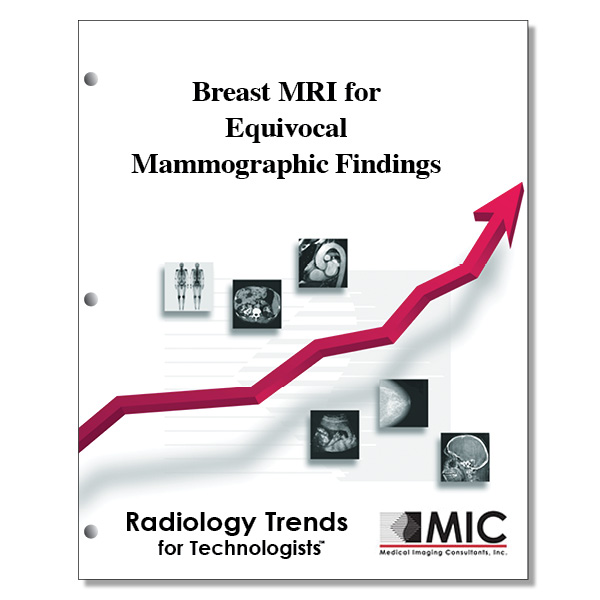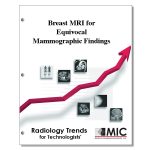

Breast MRI for Equivocal Mammographic Findings
The indications for problem-solving MR imaging of the breast following an equivocal mammographic examination are presented.
Course ID: Q00498 Category: Radiology Trends for Technologists Modalities: Mammography, MRI, Sonography2.0 |
Satisfaction Guarantee |
$24.00
- Targeted CE
- Outline
- Objectives
Targeted CE per ARRT’s Discipline, Category, and Subcategory classification for enrollments starting after February 17, 2023:
[Note: Discipline-specific Targeted CE credits may be less than the total Category A credits approved for this course.]
Breast Sonography: 1.00
Patient Care: 1.00
Patient Interactions and Management: 1.00
Mammography: 2.00
Procedures: 2.00
Mammographic Positioning, Special Needs, and Imaging Procedures: 2.00
Magnetic Resonance Imaging: 2.00
Procedures: 2.00
Body: 2.00
Registered Radiologist Assistant: 2.00
Procedures: 2.00
Thoracic Section: 2.00
Outline
- Introduction
- Diagnostic Mammographic Evaluation
- Diagnostic US Evaluation
- Problem-Solving MR Imaging
- The One-View Finding
- Technical Differences versus True Change in a Lesion
- Biopsy Challenges
- Limited Biopsy Options
- Concordance Issues
- Diagnostic Situations Where MR Imaging May Be Unhelpful
- False-Negative and False-Positive Breast MR Imaging
- American College of Radiology Recommendations
- Conclusion
Objectives
Upon completion of this course, students will:
- understand the uses of diagnostic MR imaging for lesions
- describe the MR imaging role for localizable breast findings
- explain how often diagnostic MR imaging is used for uncertain mammographic findings
- state the percentage of mammograms in the Moy et al study that were equivocal and referred for problem-solving MR imaging
- explain when the technique of spot compression should be performed
- express the type of pressure needed for spot compression views
- state which imaging modality is likely to reduce the number of diagnostic views needed to evaluate potential lesions
- recall which imaging modality is the mainstay for the diagnosis of non-calcified mammographic findings
- list pathologic conditions in which targeted ultrasound may not show a correlate to a mammographic finding
- list non-pathologic factors that can influence the detection of an ultrasound correlate
- list the studies that have evaluated diagnostic MR imaging for various problematic mammographic findings
- reiterate the number of problematic lesions reported on by the Lee et al study
- select the study that included outcomes based on suspicious mammographic or ultrasound findings for MR imaging
- associate summation artifacts with one projection mammographic images
- relate low density one-view mammographic findings to stereotactic biopsy targeting
- list the benign histologic findings that occur commonly, may be found incidentally, and make radiologic-pathologic concordance uncertain
- list the technical factors that may contribute to lesions being called equivocal
- explain how the change in patient factors affects the appearance of breast tissue
- list the factors that can affect the appearance of the lumpectomy bed at mammography
- state the imaging modality that is useful for distinguishing local recurrence from post-treatment changes in breast tissue
- choose the best diagnostic procedure when a significant breast lesion is suspected
- list the benefits of ultrasound guided core biopsy
- state how blood or lidocaine may affect stereotactic breast biopsies
- state the best patient position for biopsy of posterior breast lesions
- define “doubling down”
- explain the diagnostic situations in which breast MR imaging is NOT helpful
- recall the most sensitive breast imaging modality for the detection of invasive breast malignancies
- explain how invasive breast cancer enhances on MR breast imaging
- state how DCIS typically manifests at mammography
- list the study on problem-solving MR imaging that reported no false-negative malignancies
- state the likelihood of incidental lesions appearing on problem-solving MR imaging
- explain how enhancing lesions may lead to follow-up MR imaging
- state the current edition of the ACR BI-RADS Mammography Altas
- state the ACR BI-RADS edition that discourages the use of BI-RADS “0” when MR imaging is recommended
- review the management algorithm for appropriate use of problem-solving MR imaging for mammographic lesions
